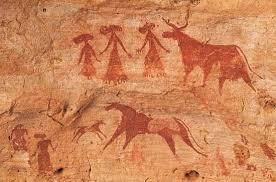Prehistoric Arts & Culture | KPSC KAS Preparation: All subjects - KPSC KAS (Karnataka) PDF Download
Introduction
- Prehistory refers to the time period in human history before the existence of written records, which mark the beginning of recorded history. In a broader context, it encompasses all the time that preceded human existence and the development of writing systems.
- Human prehistory is categorized into three sequential periods, each named after the dominant tool-making technologies of the time:
- Stone Age: Characterized by the use of stone tools.
- Bronze Age: Defined by the use of an alloy of copper and tin.
- Iron Age: Marked by the use of iron tools.

Stone Age
The Stone Age is so named because stone was the primary material used for various purposes, including hunting. During this period, humans lived in groups and constructed shelters using leaves and branches. They often resided in rock caves, with their primary mode of survival being food gathering, particularly in the early Stone Age.
The Stone Age is further divided into three stages based on the types of stone tools used:
- Palaeolithic Age
- Mesolithic Age
- Neolithic Age
Palaeolithic Age
The first period of the Stone Age is known as the Palaeolithic Age. During this time, humans used crude stone tools for various purposes, particularly hunting. In addition to stone, they used bones, ivory, and wood as weapons. Clothing was made from hides and bark, and animal bones were repurposed as needles for sewing.
Key Features of the Palaeolithic Age:
- Tool Usage: Primitive stone tools were primarily used for hunting and other activities.
- Lifestyle: People were food gatherers and did not cultivate crops.
- Social Structure: Hunting was a collective activity, often led by the strongest individuals. There was no distinction in roles based on gender, and both men and women participated equally in hunting.
- Use of Fire: Fire was used for cooking and providing light.
The various applications of these basic stone tools during the Palaeolithic period are listed below.
Palaeolithic Sites
Many Palaeolithic Age sites have been discovered worldwide, with numerous cave paintings found in different locations. These paintings offer invaluable insights into early human life.
The following information has been gleaned from these Palaeolithic Age cave sites:
- Colors in Paintings: Different colors were used in these cave paintings, created from a mixture of plant extracts and powdered laterite.
- Themes: Most paintings depict animals and scenes related to hunting.
- Lighting: Animal fat was used as fuel for lighting in caves where natural sunlight was insufficient.
- Hunting Evidence: The hunting scenes provide evidence of early humans’ strategic planning of hunting grounds and prey.
- Ceiling Paintings: Some paintings were created on cave ceilings, demonstrating the early humans’ dexterity.
- Archaeological Finds: Remnants of cooked food, ashes, animal bones and skulls, as well as leftovers of fruits, vegetables, and freshwater fish, have been discovered in these caves.
Important Palaeolithic Sites
- Lascaux (France)
- Bhimbetka (Madhya Pradesh)
- Kurnool Caves (Andhra Pradesh)
- Altamira (Spain)
- Nagarjunakonda (Andhra Pradesh)
- Hungsi (Karnataka)
- Chauvet (France)
- Narmada Valley (Madhya Pradesh, Maharashtra, Gujarat)
Features of Palaeolithic Rock Paintings
- The rock paintings from this period can be categorized into three types: depictions of humans, animals, and geometric patterns, typically in colors such as white, black, and red ochre.
- Humans are usually represented in stick-like forms, while the paintings also feature wavy lines, rectangular geometric designs filled with patterns, and groups of dots. The earliest paintings were done in black, followed by red ochre, and then white.
|
82 videos|83 docs
|
FAQs on Prehistoric Arts & Culture - KPSC KAS Preparation: All subjects - KPSC KAS (Karnataka)
| 1. What are some examples of prehistoric art forms? |  |
| 2. How did prehistoric people create art without modern tools? |  |
| 3. What is the significance of prehistoric art in understanding ancient cultures? |  |
| 4. How did prehistoric art contribute to the development of human civilization? |  |
| 5. What are some challenges in preserving prehistoric art for future generations? |  |
















